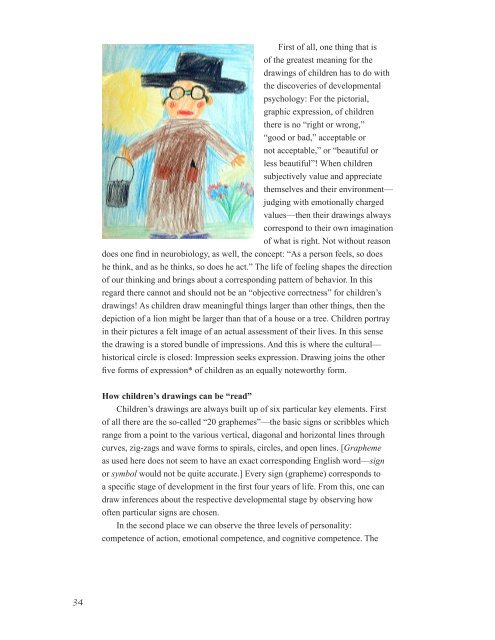Observing the Class Observing the Children - Research Institute for ...
Observing the Class Observing the Children - Research Institute for ...
Observing the Class Observing the Children - Research Institute for ...
You also want an ePaper? Increase the reach of your titles
YUMPU automatically turns print PDFs into web optimized ePapers that Google loves.
34<br />
First of all, one thing that is<br />
of <strong>the</strong> greatest meaning <strong>for</strong> <strong>the</strong><br />
drawings of children has to do with<br />
<strong>the</strong> discoveries of developmental<br />
psychology: For <strong>the</strong> pictorial,<br />
graphic expression, of children<br />
<strong>the</strong>re is no “right or wrong,”<br />
“good or bad,” acceptable or<br />
not acceptable,” or “beautiful or<br />
less beautiful”! When children<br />
subjectively value and appreciate<br />
<strong>the</strong>mselves and <strong>the</strong>ir environment—<br />
judging with emotionally charged<br />
values—<strong>the</strong>n <strong>the</strong>ir drawings always<br />
correspond to <strong>the</strong>ir own imagination<br />
of what is right. Not without reason<br />
does one find in neurobiology, as well, <strong>the</strong> concept: “As a person feels, so does<br />
he think, and as he thinks, so does he act.” The life of feeling shapes <strong>the</strong> direction<br />
of our thinking and brings about a corresponding pattern of behavior. In this<br />
regard <strong>the</strong>re cannot and should not be an “objective correctness” <strong>for</strong> children’s<br />
drawings! As children draw meaningful things larger than o<strong>the</strong>r things, <strong>the</strong>n <strong>the</strong><br />
depiction of a lion might be larger than that of a house or a tree. <strong>Children</strong> portray<br />
in <strong>the</strong>ir pictures a felt image of an actual assessment of <strong>the</strong>ir lives. In this sense<br />
<strong>the</strong> drawing is a stored bundle of impressions. And this is where <strong>the</strong> cultural—<br />
historical circle is closed: Impression seeks expression. Drawing joins <strong>the</strong> o<strong>the</strong>r<br />
five <strong>for</strong>ms of expression* of children as an equally noteworthy <strong>for</strong>m.<br />
How children’s drawings can be “read”<br />
<strong>Children</strong>’s drawings are always built up of six particular key elements. First<br />
of all <strong>the</strong>re are <strong>the</strong> so-called “20 graphemes”—<strong>the</strong> basic signs or scribbles which<br />
range from a point to <strong>the</strong> various vertical, diagonal and horizontal lines through<br />
curves, zig-zags and wave <strong>for</strong>ms to spirals, circles, and open lines. [Grapheme<br />
as used here does not seem to have an exact corresponding English word—sign<br />
or symbol would not be quite accurate.] Every sign (grapheme) corresponds to<br />
a specific stage of development in <strong>the</strong> first four years of life. From this, one can<br />
draw inferences about <strong>the</strong> respective developmental stage by observing how<br />
often particular signs are chosen.<br />
In <strong>the</strong> second place we can observe <strong>the</strong> three levels of personality:<br />
competence of action, emotional competence, and cognitive competence. The

















